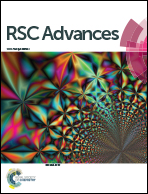Capacity-increasing robust porous SiO2/Si/graphene/C microspheres as an anode for Li-ion batteries†
Abstract
Robust porous SiO2/Si/graphene/C microspheres have been successfully synthesized by a simple two-step process of ultrasonic spraying and partial magnesiothermic reduction. The 3-D porous microspheres consist of Si/SiO2 nanoparticles (around 5–10 nm) covered by a layer of carbon and connected by graphene. We explored the electrochemical properties of the porous microspheres as an anode for lithium ion batteries (LIBs). In SiO2/Si/graphene/C microspheres, numerous pores could leave enough room for volume expansion and contraction of silicon during lithiation and delithiation, and provide large space voids for electrolyte reserves. Meanwhile, graphene plays a role in reinforcing the porous structure. The prepared sample shows superior cyclability with a discharge capacity of 1104.9 mA h g−1 in the second cycle and 1141.6 mA h g−1 over 200 cycles at a current density of 0.1 mA cm−2. The capacity retention is more than 100%, making it very promising as a future LIBs anode.


 Please wait while we load your content...
Please wait while we load your content...